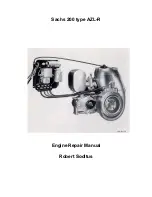
5
INSTALLATION AND MAINTENANCE
CPLS drip-proof 3-phase induction motors
4240 en - 2014.09 / b
LEROY-SOMER
1.2 - Storage
Prior to commissioning, machines should be stored:
- Away from humidity: at relative humidity levels above 90%,
the machine insulation can drop very quickly and become
virtually non-existent at around 100%. The state of the anti-rust
protection on unpainted parts should be monitored.
For very long storage periods the motor can be placed in
a sealed package (for example heat-shrunk plastic) containing
sachets of desiccant:
- Protected from frequent significant temperature variations to
prevent any condensation during storage.
- If the area is subject to vibration, try to reduce the effect of this
vibration by placing the motor on a damping support (rubber
plate or similar) and turn the rotor a fraction of a turn once
a fortnight to prevent the bearing rings from becoming marked.
Even if the motor has been stored in the correct conditions,
certain checks must be carried out before it is started up:
Greasing
Sealed bearings (cannot be regreased)
Maximum storage: 3 years. After this time, replace the bearings
(see section 6.1).
Bearings which can be regreased
Greases used by LEROY-SOMER
Grade
2 grease
Grade
3 grease
Storage
period
less than
6 months
less than
1 year
The motor can be commissioned
without regreasing
more than
6 months
less than
1 year
more than
1 year
less than
2 years
Regrease before commissioning, as
described in section 3.1
more than
1 year less
than 5 years
more than
2 years less
than 5 years
Dismantle the bearing
- Clean it
- Replace the grease completely
more than
5 years
more than
5 years
Change the bearing
- Regrease it completely
CPLS motors are lubricated with EXXON UNIREX N3 grease
as standard (grade 3).
2 - ASSEMBLY
2.1 - Checking the insulation
Before starting the motor, it is advisable to check
the insulation between the phases and earth,
and between phases.
This check is essential if the motor has been stored for longer
than 6 months or if it has been kept in a damp atmosphere.
This measurement must be carried out using a megohmmeter
at 500 V D.C. (do not use a magnetoelectric system). It is better
to carry out an initial test at 30 or 50 volts and if the insulation
is greater than 1 megohm, carry out a second test at 500 volts
for 60 seconds. The insulation value must be at least
10 megohms in cold state.
If this value cannot be achieved, or if the motor may have been
splashed with water or salt spray, or kept for a long period in
a very humid place or if it is covered with condensation, it is
advisable to dry the stator for 24 hours in a drying oven at
a temperature of between 110° and 120°C.
If it is not possible to place the motor in a drying oven:
- Switch on the motor, with the rotor locked, at 3-phase A.C.
voltage reduced to approximately 10% of the rated voltage, for
12 hours (use an induction regulator or a reduction transformer
with adjustable outlets).
- Or supply the 3 phases in series with a D.C. current, with the
voltage at 1 to 2% of the rated voltage (use a D.C. generator
with independent excitation or batteries for motors of less
than 22 kW).
- NB: The A.C. current must be monitored using a clamp
ammeter, and the D.C. current using a shunt ammeter. This
current must not exceed 60% of the rated current.
It is advisable to place a thermometer on the motor housing:
if the temperature exceeds 70°C, reduce the indicated voltage
or current by 5% of the original value for every 10° difference.
While it is drying, all the motor orifices must be open
(terminal box).
Warning: If the high voltage test, carried out at
the factory before despatch, needs to be
repeated, it should be performed at half the standard
voltage, ie: 1/2 (2 U+1000 V).
Prior to commissioning for all motors: Rotate
the motor at no load (no mechanical load), for
2 to 5 minutes, checking that there is no abnormal noise.
Before testing at no load and without coupling,
secure the shaft extension key!
Summary of Contents for CPLS 112
Page 27: ......






































